Spider-man 3 delivers on its promise with three sensational CG villains and new side to the web-slinging superhero. Bill Dawes and Kelsey Brookes go behind the scenes with the Sony Pictures Imageworks VFX and animation team of what is reported to be one of the most expensive movies ever made.
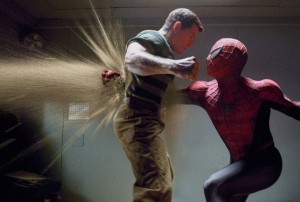
It is believed to be the costliest movie ever made, and Spider-Man 3 pushed the creative team to new heights for a supercharged sequel with approximately 20% more effects shots than the previous film.
The main VFX challenges were in creating the new on-screen villain Sandman and the “goo†that becomes the costume for the black Spider-man and eventually Venom. Imageworks also devoted a great deal of attention to their environment pipeline in order to be able to handle the increased shot workload.
“We tried to make everything better, we wanted to see if we could improve our environment pipeline which was pretty good already. Once we saw the amount of work we had to do on this movie it became clear we had to work as fast and efficiently as possible,†said digital effects supervisor Peter Nofz.
Up to 250 people at Imageworks created more than 900 effects shots for Spider-man 3. The storage requirements during production were enormous with close to 50 terabytes of material online at any one time, with up to 5000 processors working to render shots out overnight.
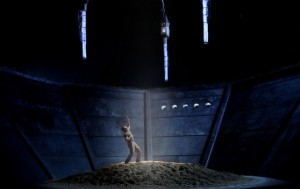
Two of the most spectacular involve the molecular deconstruction of the character played by actor Thomas Haden Church and his rebirth as the Sandman.
The creation of the tools to animate the Sandman and his sandy components required three years of software development in addition to a pipeline in Maya and Houdini.
Despite the massive increase in effects shots, the animation team, led by Animation Supervisor Spencer Cook, utilised a more blended approach to creating digital doubles than has previously been the case. Where the first two films often utilised full-body digital doubles for high-intensity action sequences, Cook’s team opted to blend live-action plates of actors heads with digital bodies to create a heightened sense of realism.
While not applicable to every shot, the use of live-action head placement was considered vital to creating more convincing digital doubles than has previously been possible. Digital doubles are used when the shot requires actions the human body cannot sustain, in the case of Spiderman, this includes enormous strength that facilitates massive leaps, swinging on web-lines through city blocks and hauling over fifty times Peter Parker’s body weight.
Spidey’s comic book heritage has also played a large role in developing the look and feel of the character. Artists regularly need to convey action and motion in a static medium, so there is an enormous body of work, decades of ready-made storyboards that have been utilised throughout the creation of the entire Spiderman series.
Although the costume itself is based on a version first introduced by artist Todd McFarlane in the late 80s, McFarlane’s rendering of Spiderman in action was considered too extreme to use as reference art. Instead Cook and his team turned to the work of iconic 70’s artist John Romita Snr whose work on the Spiderman comics of that era provided inspiration for many of the hero poses and distinctive Spidey moves throughout the film.
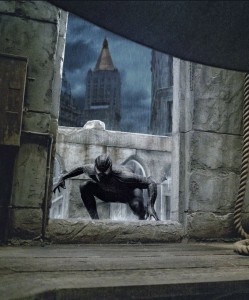
All of the digital character technology was upgraded forSpider-man 3. All of the digital character technology was upgraded for Spider-Man 3. The Light Stage 2 process at the University of Southern California was used to do a scan of the upper body of a stunt actor in costume for the first time. In the previous two films had only been used to capture the effect of lighting on the actor’s faces.
“That enabled us to record how the costume reacted to light, especially to individual light sources.†said Nofz.
“We used that footage to reexamine all the shader parameters that we’d dialled in to previous costumes and discovered that we’d been working with shaders that had a series of bugs that we’d never found before.
“The complexity was so much greater for this film. In so many shots, instead of just having one villain we had two and even 3.
“We had a lot more shots with CG backgrounds in this movie and the number of elements we received to make the shots was higher.
“We edited within the frame so much more. In order to use several different passes of facial performance for a particular shot we might use a couple of frames from one take then a couple of frames from another take and then in the middle we would throw in a couple of frames from the CG face.â€
Even in its goo-state, the symbiote presented challenges for the animation team. With no skeletal structure and no physical parameters like anything in the real world, it proved pointless to attempt to rig the fledgling creature. Instead the team pieced together the animation shot by shot, attempting to convey intent and emotion in a creature with no arms, head or body!
Despite the increase in villains (and villain effect complexity!) the size of the animation team was kept to almost the same level as that of Spiderman 2 – around 20 animators. One factor that helped streamline the pipeline was a new pre-viz methodology that, like all good ideas, might seem a little obvious in hindsight.
In Spiderman 2, the pre-viz team would work with Raimi to to define the overall ‘digital storyboard’ for the effects sequences and output the visual as a guide for the effects team. The main bottleneck occurred due to the pre-viz team working in Lightwave and outputting their files as standard movie files which the effects team, working in Maya, would then need to build up from scratch.
For this latest incarnation, the effects team moved the pre-viz team onto Maya, gave them their own rigs and collaborated quite closely early on to roughly translate the storyboards into animatics. This technique allowed Raimi to work closely with the pre-viz team to quickly try different animation scenarios without the expense of a full-blown shot and the new pipeline smoothed the transition to cinematic quality by providing the animation team with a close approximation of the expected shot in a file format they could work with.
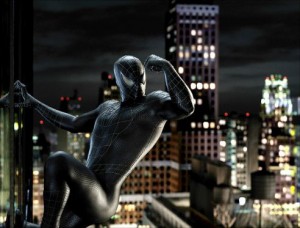
Another tool that streamlined the process was a physics tool, giving the animators a better feel for how an object at velocity (usually the hero of the piece) should behave under realistic physics conditions. A very simple tool to work with, the physics tool simply analysed two frames; the last frame where Spiderman (or a villain) is still touching a fixed object and the next frame after he leaves the object. By calculating the distance between the objects in two frames, the simulator could approximate the speed and direction the object was moving in, which is the definition of ‘velocity’. Once the velocity is known the simulator calculates the effect of gravity on the object and draws an appropriate parabolic curve outlining its correct descent. Although this gave a reasonably precise effect, real-world physics is often not dramatic enough for the world of film.
“We’d use this To judge the real-world physics of what Spiderman was doing,” Says Cook. “In same cases we’d say ‘this looks good, let’s use it’ in other cases we’d disregard it because movie physics and real-world physics are sometimes two different things and we needed to make the movie exciting and dramatic and cinematic. So we pushed real-world physics further than it would normally go, even if a person had that much strength.”
Just like his villainous counterpart, the Sandman’s physical body wasn’t set in flesh, let alone a material less malleable. Changing form as required, the Sandman draws on the surrounding environment to create his silica body – if that environment includes a city building project, then the animation’s team challenges grow alongside the suddenly Godzilla-sized villain. The main consideration, apart from the continuing sand simulation, was in making a lumbering, 50-foot sand-monster weighing many, many tons move consistently with its mass yet still appear dangerous.
That challenge, however, was one that Spencer Cook had been waiting for all his life:
“I’m really proud to have been able to work on a movie with giant monsters. I grew up with Godzilla and Harryhausen’s work and I love giant monster movies. So when Sam started telling me about this final battle scene, and he says ‘the Sandman then grows to fifty feet tall’, I was like yes, yes! So, I’m really happy to have done some really cool giant monsters. The giant Sandman and then the giant venom creature at the end of the film were really a lot of fun to animate. Really difficult, but a huge amount of fun so that stuff was great.”
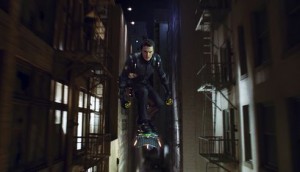
Even in the tightly filmed battle sequences, many of the buildings in close-up and the midground were capture on film in second unit photography or by texture mapping digital photographs onto 3d models of the Manhattan cityscape.
Visual Effects Supervisor Scott Stokdyk said “whenever we felt we could introduce a live background we tried to do it.â€
“It always helps to have real elements to tie everything in. Even if plates aren’t that useful when it comes back to us at imageworks its great reference and its good to have a piece of film as it gives all the artists a target.
“We did build a photogrammetry pipeline but did not use it that much for buildings that were farther out but often in that case resorted to second unit photography.â€
Venom is a dual creature, the deadly combination of Spidey-hating Eddie Brock and an alien symbiote capable of projecting its aggressive tendencies onto those it partners with. While technically a biped (at least, while not a leaping pile of goo), the very type of exaggeration the animation team avoided in Spiderman was used extensively to convey sheer animal nature of Venom. Spencer Cook’s animators used reference footage of predatory animals, lions and cheetahs, for inspiration on Venom’s movement. When asked how the signature look was achieved, Cook responds:
“Mostly, in how he crouches!”
By lowering a biped to its haunches, bring the elbows up and creating a claw-like flex of the fingers, it’s possible to create a body language that conveys pure aggression. Add that to enormous teeth and an equally cavernous maw and you have something that is, in Cook’s terms, ‘savage as hell.’ He goes on to explain:
“When he’s leaping around and doing stuff more actively, we’d really exaggerate the poses in general. So if he was bringing his knees up, we’d bring them up a little bit further than we would with Spidey. When he’s crawling around we’d try to keep his elbows up a bit more so he looked different from Spidey and it gave him a little bit more of an inhuman feel. So in general he was a little more exaggerated, but still in keeping within human parameters too because we didn’t want him to look too cartoony.”
For even more Spiderman coverage check out the Special May edition of Digital World Magazine which has an even more indepth look at some of the digital scenes from the movie. Digital World Magazine is published in Australia – Bill Dawes is the Editor in Chief.
